After all the intial work at Wimbledon on sports events in virtual worlds I was often asked about the London 2012 Olympics and what it migh mean for them. I wrote a document with some ideas, almost a little dated now but it was November 2006.
After a recent event explaining all things metaverse I was prompted by a note (thankyou J) asking about the implications and potential for 2012 to try and get some more traction on this.
There are lots of people in companies on loan to 2012, but there is also still a good few years to go development wise. So, to capture our thoughts as a community I just set up a PBWiki.
It is here https://virtualworldolympics2012.pbwiki.com/ as an extended open to anyone eightbar project. If you want to come and share some ideas about how we can get people to represent sports events in a richer way, and if it does not cuase you any commercial conflicts and you want to do the right thing, then please come and join in. We have 4 years 😉
So, virtual world, mirror world, augmented reality, gaming, social media, crowd content creation, 3d printing etc, all up for discussing. (yes this really should have been a superstruct type project, but lets try and grab some people into this who dont normally do social media too ;))
* also if I could figure out how the london 2012 website let me blend with it, trackback, or hook in anyway I would !
Category Archives: Technology
Irving and Obama – Fantastic Innovation News
Some fantastic news is zooming around the internet right now. A former IBM Vice President and now MIT visiting professor Dr Irving Wladawsky-Berger is now on President Elect Obama’s Technology and Innovation Panel.
This is significant because Irving is a great visionary and for us here at eightbar has been a very key supporter from the very early days of virtual worlds. Sandy Kearney was working closely with Irving when we first met and serendipty kicked in.
Irving has been trying things out and blogging for many years too. So we can all rest assured that he “gets it”.
Quite a day given our CEO Sam Palmisano has joined in on an exciting discussion around social media inside IBM today.
(Thanks aneel for tweeting this news in the first place )
Little Big Planet is even more flexible than I thought
I realized stickers could be put on Sackboy, and that using the camera you could make sticker. Hence.
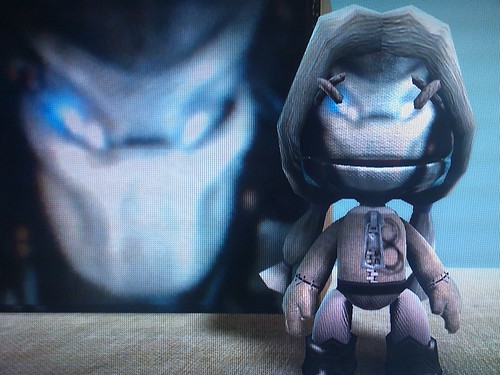
Here is a little epredator, also wearing an 8 for eightbar. That is just a bit of avatar customization but immensly powerful. I am sure we shall see some amazing decorated sackboys.
Little Big Planet on PS3 powered by the co developed IBM, Sony, Toshiba cell processor 🙂 with an injection of eightbar.
Google Lively set to shut december 31st
It is official Google have decided to close Lively at the end of the year. This will no doubt create a great deal of discussion about the future of the virtual world industry, maybe give some nay sayers some ammunition to be negative.
I do feel somewhat sad for those people that were the allowed developers and beta testers who created content, who spent time and effort making things and creating. They now have to make do with video and photos of their work.
Google does of course still have the mirror world Google Earth, which as I have said before we looked at a good few years ago when sat in the Wimbledon bunker and said “wouldn’t it be great to put the tennis scores and rallies on that”. Earth of course also has user created content, the 3d warehouse. It does not have the presence of other people as such.
Lively had the presence of other people, used a plugin in the browser but stuck to the room approach and only let a select few develop on it. This isolationism certainly stopped me from “having a tinker building things”. Yet the more open worlds, ones with UGC, with the ability to see the potential by using the creation tools, they are the effective ones.
Not everyone needs to build, but they do feel they need to have some sort of creative control over the world around them, or potential too. Its an important point and one we proved to ourselves on the Torque metaverse.
Anyway, well done to the Google Lively team for having a go, what you, and we have all learned can make the other worlds better.
Inspired by the social entrepreneurs – 3d Printing for the world
I have just spent 2 days fully immersed in the chain reaction event in London. At this very vibrant event I was expecting to spend most of my time explaining to people how we use the web and virtual worlds to communicate, to get things done, to power change in business. I certainly did get to do that, but I also got to meet and talk with a whole host of people from very varied backgrounds who had fantastic stories and goals.
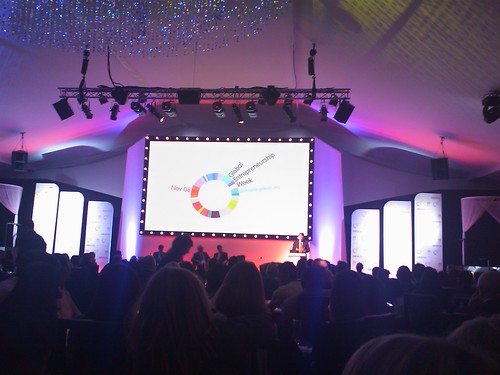
Many of the people at the event were social entrepreneurs. People who work for change in the commnuity and an better world, not merely profit. In fact seldom for profit.
There was of course a balance as there were some very important business leaders at the event and the prime minister at one point. They spoke of generating wealth, of running successful businesses but then setting up foundations and mentoring schemes. There were also a large set of the attendees(contributors) who were of a much younger demographic. Young people who were willing to hear about how they can make a difference, or more often those that already were just getting on with it.
One of the huge messages, and the biggest take aways from this was that you do not have to wait to get started doing anything. As Dr Victoria Hale (founder of One World Health the not for profit pharmacutical company) said, just when is it that you will have enough money, resources, people or power to do what you feel you need to do to change the world for the better? You just have to start.
There was a meta layer to the event in talking with production team called in to help with the social media reporting. All very experienced web 2.0 people. So we all had a lot in common and had some breakout sessions on where this is all going, and what the best way to produce events, gather whats happening and distribute it.
Finally the chain reaction is about the links people have made sparking ongoing work. The third sector (a very strange name but its a tribal label) is there to make a difference to the world. I wrote a commitment to be placed on the wall, one of many that were added that I want to get the technology of 3d printing, local manufacture to be distributed and practical around the world. Being able to manufacture designs from 3d data held elswhere in the world could allow local communites to manufacture the things they need from simpler raw materials. Imagine being able to fix a broken water pump, or create new water carrying vessels without the need to have products shipped to remote, deprived areas. Think one laptop per child, people finding the parts they need online or co-desiging them in a virtual world with remote engineering experts and add local 3d printing manufacturing abilities, making the virtual designs real to fix any problem. Now that can change the world, and I can help make that happen.
Chain Reaction – Changing the world tomorrow
It’s time to go and inspire the next generation of entrepreneurs at a 2 day event in London called Chain Reaction. “Chain Reaction is a unique and challenging project based on a very simple idea – that none of us on our own can change the world, not governments, not businesses, not charities. We succeed when we work together”. Sounds familiar doesnt it 🙂 Tribes? Smart Planet? Eightbar? well thats why I am heading along to share my experience and learn from others too.
Well a whole host of industry leaders will be offering their time and their insight to the audience of 1,000+ people, mostly under 30 years of age apparently.
Our UK Chief Exec Brendan Riley is in a session on the monday. Also Andy Dean ( a fellow eightbar from Hursley and I) will be in attendence for the full event, probably running the odd workshop here and there, mingling and helping people realize their full potential.
For me to be able to either talk about life online, the rise of metaverses or the story of eightbar and Godin’s tribes approach should keep me failry sparked and busy for the event. If I can persuade even just one person to just start doing, dont wait, dont overplan, start. Then it will be a success.
The main speakers are really awesomely impressive, including the great Richard Branson
So if you are going to be there, come and say hi.
Chainreaction in on twitter and spread over the web as you might expect and I am sure many of us will be live twittering, webcasting etc as its that kind of event.
From Little Big Planet to a Smart Planet
As you know we don’t usually do press releases or “official” stuff here on eightbar, but the very recent words from Sam Palmisano around the drive for a Smart Planet do fit in rather well with what we have been doing over the past years.
Firstly Smart Planet is not directly named after our very own Rob Smart, but just as Second Life surnames act to aid serendipity we should not ignore that link.
Secondly, this is not really related to Little Big Planet as such, but there are parallels that can be drawn.
However the main drive behind the Smart Planet is around these three themes.
First, our world is becoming instrumented
I often talk about things being instrumented, but this fits in with the approach we took to Wimbledon in SL(first blogged in 2006), an instrumented world re-envisioned and experienced. It fits with Andy SC and DCJ’s work with sensors, actuators, current cost meters etc. It was the core of my business process management pitch at VW London. If we have the data, openspimes, facts, figures, messages then we can do a whole lot with it.
Second, our world is becoming interconnected
Well…. if you are reading this blog you know this is the case. This is not just about the data but about the people. Web2.0 and virtual worlds have connected us all in incredible ways, formed new tribes of interest, brought eightbar into existence. Being able to create and share across company and cultural boundaries, breaking geography, all fit into this from what I can see. This is where Little Big Planet fits too, even Sony dipping their toe into the great creative power of user created content.
Third, all things are becoming intelligent
This is the extra leap, but we can apply compute power to vast amounts of data as a service. We can also apply human power, the wisdom of crowds. Things are not isolated units of processing. We can gather insight and points to innovate on with more simulations and visualizations at a global level.
So bring on augmented reality, transparent sharing across interested groups, remote rich interaction between people and information at distance and new ways to determine what is happening in the real world.
So to finally quote Sam Palmisano “But I think one thing is clear: The world will continue to become smaller, flatter… and smarter. We are moving into the age of the globally integrated and intelligent economy, society and planet. The question is, what will we do with that?”
Tell me that does not fit in with all the drivers of virtual worlds that we and our fellow tribe members inside and outside of eightbar have been pushing?
Two bits of wood a motor and some sponge = LBP
My Little Big Planet for the Ps3 has arrived. Aside from some crazy and cool presentation styles and levels to play it does indeed have the most fantastic building kit. Many of us the last few years have got used to just making things in places like Second Life. Little Big Planet takes a seemingly more Blue Peter style with sponge, cardboard and a lot of sticky back plastic. Now I am no expert in building things yet but a minute or so yielded this quirky creation
What is interesting is that the style is photo realistic, but the setting is very homemade, so it allows photo realistic creations to make sense even when they are rough around the edges. The slapstick cartoon intentions and even the sackboy characters go nowhere near the uncanny valley, it is all utterly believable.
Games and Business – Changing the Game
My amazon delivery arrived today of Changing the Game by David Edery and Ethan Mollick.
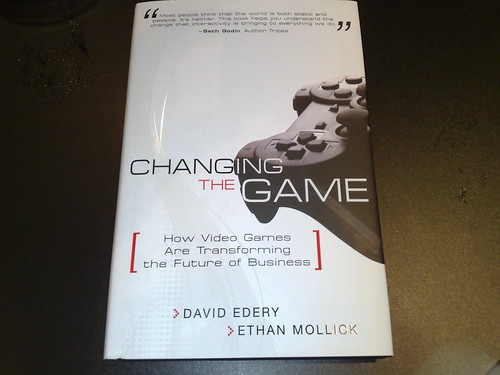
For many of us in this growing blended industry of metaverses, virtual worlds, serious games and such like this book may well be a busmans holiday. However, it is packed with evidence, facts and figures and useful imagery to help convince those who seem to think any game play elements at all in business really dont fit.
Well they do IMHO. Take a look at what David and Ethan have to say, as a great deal of business and academic experience is captured in this book.
One key element they point out is that the only way to understand anything at all about games is to play them or observe them very closely. The surface descriptions of many of the tasks and the game terminology often masks the true deep use and depth of advantages.
It is once again fitting nicely into the serendipity of life as I was having amny of these same conversations with the various visitors to my BAFTA studio session yesterday. You dont just have to make games and related environments you can use them.
Virtual Worlds London – metarati and moving coffee – Day 1 Part 1
Monday and Tuesday this week were the virtual worlds london conference So the Queen Elizabeth II conference centre across the road from parliament in Westminster was a hot bed of metarati activity.
The main conference hall is a very impressive UN like stage and sets of tables. It was hard to gauge numbers in attendence but it seemed quite busy.
The opening keynote was Mark Kingdon the new Linden Lab CEO. I had heard Mark talk at the birthday celebrations but it was also good to see him and hear how he saw Second Life now.
The pitch had to try and balance the potential of people in the audience not knowing about virtual worlds and the more experienced industry people too.
He showed lots of numbers and spoke about the growing peak concurrency and improved stability.
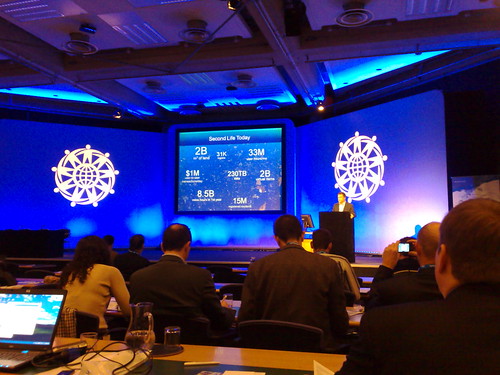
He also indicated that whilst not a product announcement as such that 1st Quarter 2009 woudl see the beta of the behind the firewall enterprise Second Life. Of some interest to us in eightbar as IBM has been part of that drive and research as we have some servers behind the firewall so I guess we are alpha participants 🙂
The drive to a more corporate approach and the enterprise market whilst not losing the creative and eclectic set of public communities is an interesting balance for Linden Lab to take. Some people did comment that the many Linden’s in attendance and Linden stand was very suited and booted as we say.
There was also a joint strategic partnership that saw Justin Bovington from Rivers Run Red take to the stage showing the immersive workspaces video and explaining it for the audience.
Also in the keynote M Linden finished on a very good point that these virtual environments whilst very much about people and integrating with others can also be a place fo great solitude and personal reflection.
Ren Reynolds(Now a Fellow of the Royal Society for the Arts (FRSA) many congrats!) twittered “@epredator virtual worlds as pause to think, now they are doing my pitch ! oh and behind F/W see Biz Case i did 3 years ago! ” and I was reminded of a post I made back in 2006 about remembering to relax in Second Life too.
After this the next session was “Trends and Numbers – Where is it all going?”. Each presenter gave a pitch. Harvey Cohen from Strategy Analytics showed some research results mainly around what ubiquity meant and needed to be and how we were not there yet. Nic Mitham of K Zero showed some of his excellent charts on worlds, demographics and those new middleware platforms coming of age very soon. Then Steve Prentice from Gartner aimed to remind people of my favourite opener “this is about people”
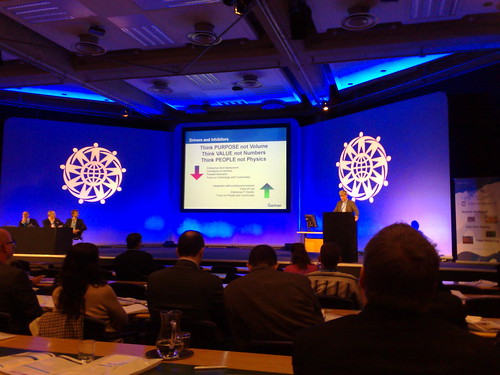
Think purpose not volume, think value not numbers, think people not physics.
(Being very much on the receiving end of trying to justify what this is all about these are things I am very much tuned into. It is almost a description of what to do with your evangelists too).
We then all went for coffee and expo time. The expo was a little odd in layout, it was over two floors that we sort of corridoors, sort of mezzanine levels. The natural flow was not to go from one floor to the other as the electives were either in the large ground floor hall or the 4th floor in more of a long office. The moving coffee reference in the title was because each coffee break the coffee would rez on a different floor to induce a green dot effect and have people mingle around the stands with some sort of engineered distribution. Of course virtual worlds, whilst getting more serious and business like, tend to attract a more up and at ’em audience and I am not sure the coffee moving was very popular.
The expo had a few stands but was no where near as large as the US expos. IBM did not have a stand either though there were a few of us there speaking. The biggest and most populated and staffed stand though was the Second Life one.
The first elective I attended was Defining Your Strategy: what does ROI mean to you. Chaired by the ever present Corey Bridges of Multiverse. Phillipe Moitroux of TAATU, Divinia Knowles of Mind Candy and Peter Haik of Metaversatility were the panelists. Phillipe showed a presentation ot TAATU and explained some of how they used their 2.5d flash world to integrate with marketing and media campaigns.
Corey was challenging the panel to give numbers for ROI and taking the stance that there has to be ROI for investment to be proved. Mind Candy’s Moshi Monsters though is in early take up phase, to get buy in before any monetization so there were no figures, as you would expect. Peter indicated that some of this need to be looked at as presence and that the ROI is complicated to show in that case. This led to some discussion from the audience about the balance of how to measure PR vs how to measure marketing. It made for a prickly but good start and Peter was up for arguing with Corey over the need and intent for some of the virtual world projects. Of course multiverse is more about building virtual worlds and metaversatility is about doing things in them so that is comparing two different things really anyway.
I then left the main hall and tooke the lift to the 4th floor (again bypassing the expo) for the “future of virtual collaboration in the enterprise”. Bernard Horan of Sun, Rupert Key of Malden Labs, Chris Collins Linden Lab and Paul McDonagh-Smith Nortel talked about all the various projects and directions for enteprise virtual worlds. Chris obviously added and re-iterated the keynote mention of the 1Q beta, Paul talked about the various Nortel projects and products emerging, Bernard covered many of the aspects of using multiple platforms and Project Darkstar, and Rupert described how some of the more rigourous software engineering was coming into play. He used the SOA (services orientated architecture) word first and ESB (enterprise services bus) 🙂 Small cheer from me there.
For me this session was more about the “coming of age” as Tish said, of the enterprise virtual world. All these great companies, all active, bought in, selling solutions, building solutions. Its not going to go away and may be the biggest driver for VW take up. Not everyone will play a game who works in a office, their kids might be in the kids worlds, they may explore a social media platform. However, many more people use email at work, use computers as tools of the trade. Injecting virtual worlds into that points towards the ubiquity we are straving for. That also starts to make this a “platform”, onto which new innovations will occur. All very exciting for this metaverse evangelist.
The post lunch session began for me with the “Rise of Mirror Worlds and Mirror World Applications”. Now dont get me wrong I like mirror worlds, but I was more taken with the sort of augmented mashup approach that David Burden of Daden took in showing the mirror world potential than initially the approach of Alex Wrottesly of Near and Mirko Caspar of Metaversum (Twinity). Alex was basiclaly coming out of “pseudo stealth” and sharing the Near concept of a 100% accurate model of a city with managed shop fronts and interiors for all the parties involved in the real place. Twinity was showing virtual Berlin and the sort of activities and popularity of having a real place to socialize in.
David showed google maps mashups with aeroplane arrival data and layering of reality with augmentations from various places.
David Wortley from Serious games was moderating, but I was late getting into the room so only caught the end of of his intro.
Near was challenged on the need to be 100% accurate all the time. How does that get to happen. Self management by store owners in real life seemed to be part of it. An interesting focus. Also Kevin Aires asked if someone did not have a real presence surely they could not participate. (I was thinking that too as IBM does not have any shops, not does Amazon). The answer was that if they were not in real space they would not be in the model, though it raised the notion of people buying up real estate in order to occupy the virtual model which might have a wider reach that the real place. Complicated conundrums.
Personally I think that accurate models of real places do make sense, its what the Ordnance Survey spend a lot of time creating. A sort of managed wiki approach for store front owners may seem an overhead that they may choose to not enagage with. However, an accurate model, instrumentated with whats going on the real world, a paraverse as our Collegue Peter Finn refers to them makes alot of sense. Maybe populated with openspime data. That is accurate and valuable. Though virtual tourism and visiting places clearly has its attractions. I love driving at speed around the Project Gotham version of London on my Xbox 360.
The penultimate session was virtual worlds as interactive television. I missed some of this due to another gathering elsewhere. However the gist seemed to be that television needed to adopt a way to engage with the audience and that various projects try to do this in various ways. The problem often being that simply repackaging an experience based on a TV show of film doesnt work very well, but that creating an engaging all platform experience is veyr hard to do. I was reminded of the sort of conversations that Tim Kring of Heroes fame was having in LA. He suggested that hollywood was not very good at seeing the potential, but merely treated everything as being able to shrink wrap it in the next format. Film, to DVD. etc. He, as a story teller and creator wanted to layer across all the engagement points.
The final keynote was a call to arms for the Virtual Worlds Roadmap. This needs a post in its own write as we all need to get on board with this across the industry and help. Victoria Coleman (Samsung), Sibley Verbeck (electric sheep company), Jeffrey Pope 3Di, John Hengeveld (intel) and (at last I got to meet him for real and he is now busy helping NASA work out how to deflect extinction level event asteriods from Earth!) Bruce Damer were all on stage giving their view. The main aim is to gather together and cut through use cases to understand and help people come to terms with which applications need to be built for which case.
(In my own humble way I have been trying this with my reverse ICE model)
The gathering up to now have been physical ones as people got together to solve break the problems up, but we very much need to all get involved and spread this voluntary effort across the metaverse community. I certainly would like to see the 6000 IBMers all contributing from the virtual universe community in the near future.
It’s here the virtual worlds roadmap. lets do this!
Long post… Day 2 next post
